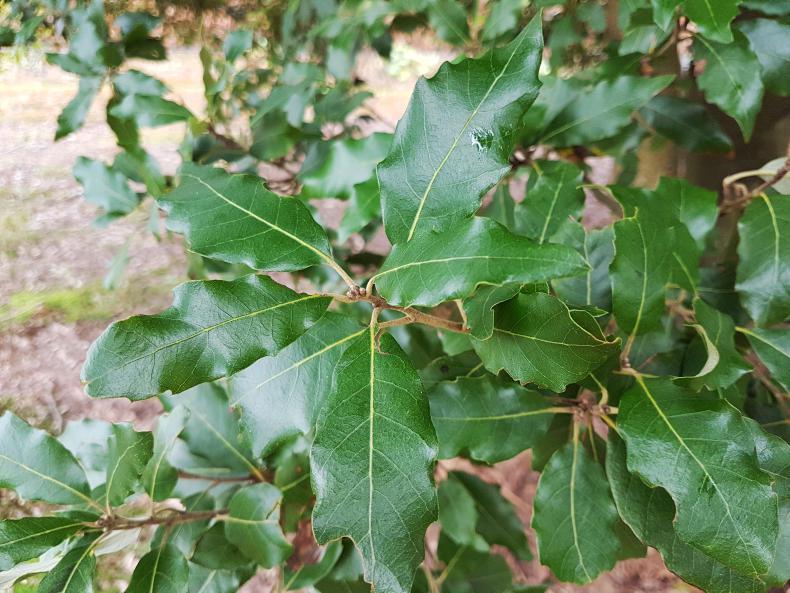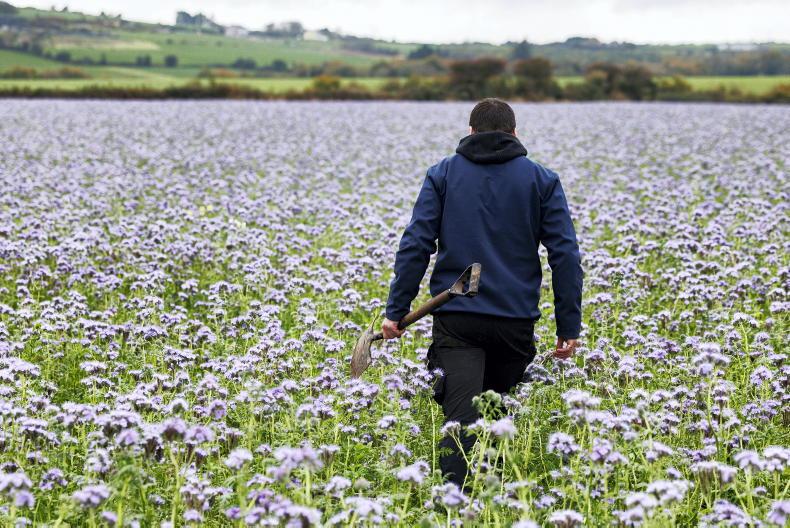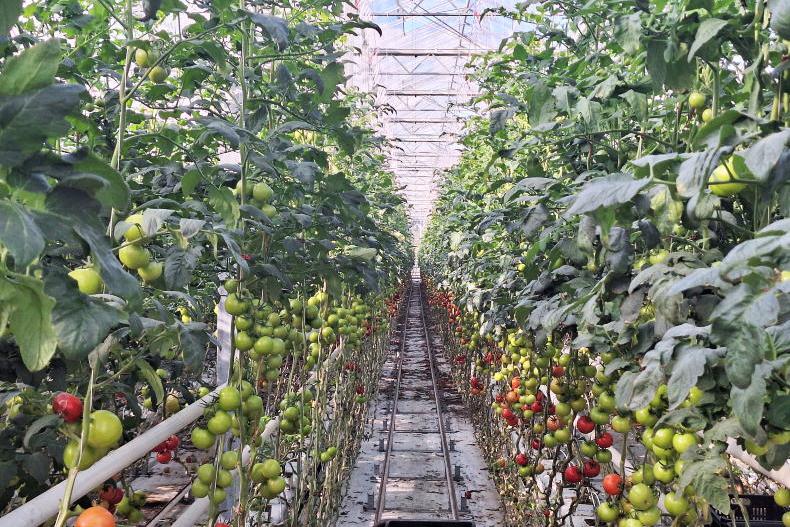On balance, holm oak is probably better-known as evergreen oak in this country, holm oak being a more English name and we struggle to know whether it should be pronounced with a silent L as ‘hom’, or ‘home’ or ‘holum’.
It helps that it is also called holly oak, the botanical name being Quercus ilex, Quercus being the Latin name for oak and ilex being the Latin for holly.
The word holm is taken by some to mean holly from Old English, or possibly Norse for an island.
So take your pick but don’t, as some increasingly do, called it ilex. That name firmly belongs to holly.
Most people are not aware that some species of oak are evergreen.
These are mostly native to regions where there is a warm, sunny summer, such as California, where they are several species of live oak, the live part just meaning they stay live, or green in winter.
There are specimens of live, or evergreen, oaks in major tree collections, such as Fota in Cork, John F Kennedy Park in Wexford, Mount Usher in Wicklow and Birr Castle in Offaly, among others, including the National Botanic Gardens in Dublin.
There are holly oaks in all collections, but these collections have other live oaks, including some American ones but these mostly struggle.
One such species, the cork oak, Quercus suber, from Portugal, the source of natural oak. It is evergreen, usually a small, slow-growing tree here. It does not make a big tree in its native range, but is grown with a clear stem so the valuable cork can be taken off in broad strips.

Holm oak.
The cork, incidentally, is an evolutionary adaptation as a defence against fire in a very dry region.
The cork is slow to ignite and protects the mature trunk and main limbs, which readily re-sprout after roaring bush fires. The Algerian oak, Quercus canariensis, is semi-evergreen, losing about half of its leaves turning yellow in autumn, looking like it omitted to shed them all.
Despite being of warm country origin, it grows well in cooler conditions and reliably makes a good specimen. Also, variably evergreen, the Lucombe oak is an 18th century cross, grown in a Devon nursery of the same name, between the cork oak and the deciduous Turkish oak, which makes a large tree here.
So the holly oak is the only evergren oak that you are likely to see outside of notable tree collections.
For a tree not well known, it is seen commonly enough in old gardens, municipal landscaping and near the coast.
Despite being a Mediterranean native it grows very well here, achieving 75cm/year in good soil, it has huge potential as a large wind-break tree, thriving in sandy soil and heavy soil as long as the ground is not water-logged in winter, which it cannot tolerate.
It stands salt gales and very strong exposure, usually unmarked, and if it is marked, little else, besides Monterey pine and a few specialist seaside small trees, such as olearia and griselinia, survives.
It can make a single trunk but is more often a multi-branched, bushy tree, clothed to the ground with foliage, if not pruned, and nothing can grow under its dark canopy.
The foliage is dark-green, almost black, and can look a bit dreary but can have other trees grown with it, including native oaks and American red oaks.
It takes cutting back very well and has very hard timber, even for an oak, which is renowned for toughness. It is very dense and heavy timber, used since Roman times for cart wheels and makes very good firewood.
Timber of burning size can be had in 15 years or so and it can be coppiced to yield again. It takes to clipping very well and makes an excellent seaside hedge to any size, but only on land that drains well.
Hydrangeas often grow too large and need to be pruned back. There are two ways to go about pruning hydrangeas and both work well. The easiest way is to simply allow the bushes to grow too large and then cut them right back to ground level every eight or 10 years, when they have grown wide and floppy, allowing them to grow and flower freely. After heavy pruning, they will not flower for two years.
Hydrangea.
By pruning each year, the size of the bush can be kept under control and the flowers can be had each year. Thin out the number of shoots each spring, taking out about one in five or six, right back to ground level or near it, thus keeping the plant small.
The longest shoots can be shortened also. Pruning should be done now.
Trees, shrubs and roses
Bush roses and repeat-flowering climbers are growing strongly and should be pruned immediately, if not already done, because the new leaves are already sprouting. Also they should be sprayed for blackspot disease if previously affected. Finish any bare-root planting that remains.
Flowers
Bedding flowers can be sown over the next 10 days or so. Start the seeds in warm conditions in a propagator or in a warm kitchen. Lifting and dividing herbaceous flowers should be completed soon. Ornamental grasses move best now. Control weeds in flower beds and borders.
Fruit, vegetables and herbs
If the ground has dried out enough, plant garlic and shallot sets without delay. Garlic needs a touch of cold while it is in the ground. New fruit trees and bushes should be planted as soon as possible. Complete the pruning of apple and pear trees and blackcurrants. Tidy up herb plants.
Lawn
Mowing should be done as soon as the ground is firm. Apply lawn mosskiller if there is heavy moss growth. Lawns can be re-seeded without cultivating by spraying off the grass and re-sowing over the dead sod. Mow down the grass to make it easier for the lawnseed to wash down.
Greenhouse and house plants
Sow seeds of tomatoes for greenhouse growing right away, also sweet peppers and chilli peppers. A sowing before mid-March will usually produce ripe tomatoes in mid-July. Delayed sowing will delay cropping. Feed and water heavily all greenhouse plants, and house plants.
Read more
Gardening tips with Gerry Daly: perfect perennials
Gardening tips with Gerry Daly: Red and blue
On balance, holm oak is probably better-known as evergreen oak in this country, holm oak being a more English name and we struggle to know whether it should be pronounced with a silent L as ‘hom’, or ‘home’ or ‘holum’.
It helps that it is also called holly oak, the botanical name being Quercus ilex, Quercus being the Latin name for oak and ilex being the Latin for holly.
The word holm is taken by some to mean holly from Old English, or possibly Norse for an island.
So take your pick but don’t, as some increasingly do, called it ilex. That name firmly belongs to holly.
Most people are not aware that some species of oak are evergreen.
These are mostly native to regions where there is a warm, sunny summer, such as California, where they are several species of live oak, the live part just meaning they stay live, or green in winter.
There are specimens of live, or evergreen, oaks in major tree collections, such as Fota in Cork, John F Kennedy Park in Wexford, Mount Usher in Wicklow and Birr Castle in Offaly, among others, including the National Botanic Gardens in Dublin.
There are holly oaks in all collections, but these collections have other live oaks, including some American ones but these mostly struggle.
One such species, the cork oak, Quercus suber, from Portugal, the source of natural oak. It is evergreen, usually a small, slow-growing tree here. It does not make a big tree in its native range, but is grown with a clear stem so the valuable cork can be taken off in broad strips.

Holm oak.
The cork, incidentally, is an evolutionary adaptation as a defence against fire in a very dry region.
The cork is slow to ignite and protects the mature trunk and main limbs, which readily re-sprout after roaring bush fires. The Algerian oak, Quercus canariensis, is semi-evergreen, losing about half of its leaves turning yellow in autumn, looking like it omitted to shed them all.
Despite being of warm country origin, it grows well in cooler conditions and reliably makes a good specimen. Also, variably evergreen, the Lucombe oak is an 18th century cross, grown in a Devon nursery of the same name, between the cork oak and the deciduous Turkish oak, which makes a large tree here.
So the holly oak is the only evergren oak that you are likely to see outside of notable tree collections.
For a tree not well known, it is seen commonly enough in old gardens, municipal landscaping and near the coast.
Despite being a Mediterranean native it grows very well here, achieving 75cm/year in good soil, it has huge potential as a large wind-break tree, thriving in sandy soil and heavy soil as long as the ground is not water-logged in winter, which it cannot tolerate.
It stands salt gales and very strong exposure, usually unmarked, and if it is marked, little else, besides Monterey pine and a few specialist seaside small trees, such as olearia and griselinia, survives.
It can make a single trunk but is more often a multi-branched, bushy tree, clothed to the ground with foliage, if not pruned, and nothing can grow under its dark canopy.
The foliage is dark-green, almost black, and can look a bit dreary but can have other trees grown with it, including native oaks and American red oaks.
It takes cutting back very well and has very hard timber, even for an oak, which is renowned for toughness. It is very dense and heavy timber, used since Roman times for cart wheels and makes very good firewood.
Timber of burning size can be had in 15 years or so and it can be coppiced to yield again. It takes to clipping very well and makes an excellent seaside hedge to any size, but only on land that drains well.
Hydrangeas often grow too large and need to be pruned back. There are two ways to go about pruning hydrangeas and both work well. The easiest way is to simply allow the bushes to grow too large and then cut them right back to ground level every eight or 10 years, when they have grown wide and floppy, allowing them to grow and flower freely. After heavy pruning, they will not flower for two years.
Hydrangea.
By pruning each year, the size of the bush can be kept under control and the flowers can be had each year. Thin out the number of shoots each spring, taking out about one in five or six, right back to ground level or near it, thus keeping the plant small.
The longest shoots can be shortened also. Pruning should be done now.
Trees, shrubs and roses
Bush roses and repeat-flowering climbers are growing strongly and should be pruned immediately, if not already done, because the new leaves are already sprouting. Also they should be sprayed for blackspot disease if previously affected. Finish any bare-root planting that remains.
Flowers
Bedding flowers can be sown over the next 10 days or so. Start the seeds in warm conditions in a propagator or in a warm kitchen. Lifting and dividing herbaceous flowers should be completed soon. Ornamental grasses move best now. Control weeds in flower beds and borders.
Fruit, vegetables and herbs
If the ground has dried out enough, plant garlic and shallot sets without delay. Garlic needs a touch of cold while it is in the ground. New fruit trees and bushes should be planted as soon as possible. Complete the pruning of apple and pear trees and blackcurrants. Tidy up herb plants.
Lawn
Mowing should be done as soon as the ground is firm. Apply lawn mosskiller if there is heavy moss growth. Lawns can be re-seeded without cultivating by spraying off the grass and re-sowing over the dead sod. Mow down the grass to make it easier for the lawnseed to wash down.
Greenhouse and house plants
Sow seeds of tomatoes for greenhouse growing right away, also sweet peppers and chilli peppers. A sowing before mid-March will usually produce ripe tomatoes in mid-July. Delayed sowing will delay cropping. Feed and water heavily all greenhouse plants, and house plants.
Read more
Gardening tips with Gerry Daly: perfect perennials
Gardening tips with Gerry Daly: Red and blue











SHARING OPTIONS